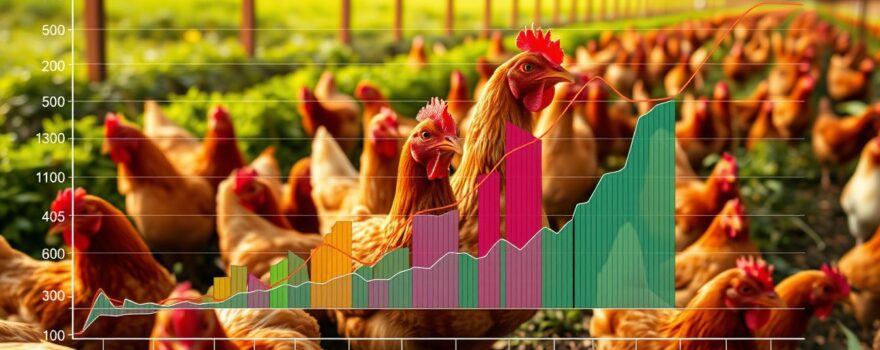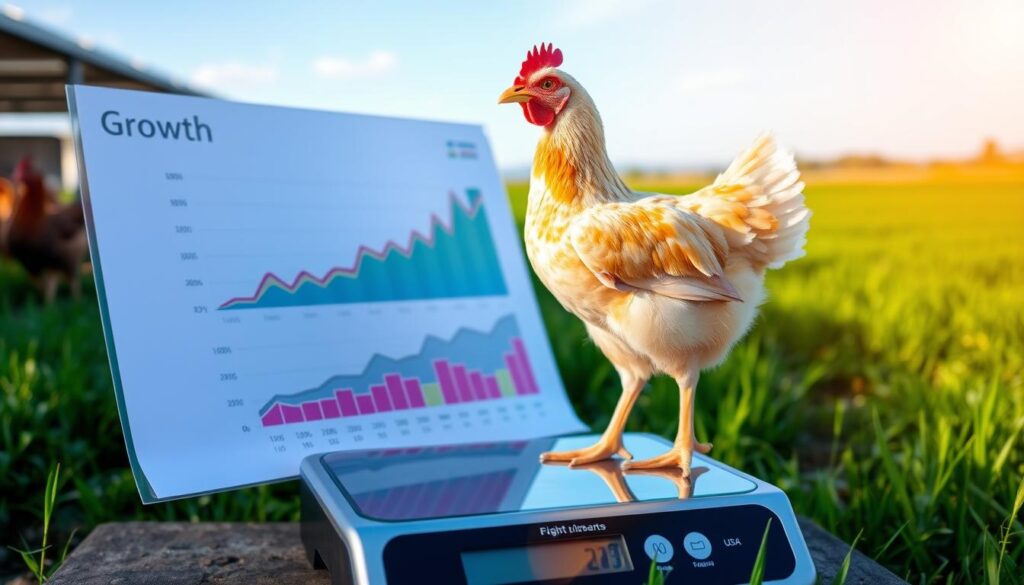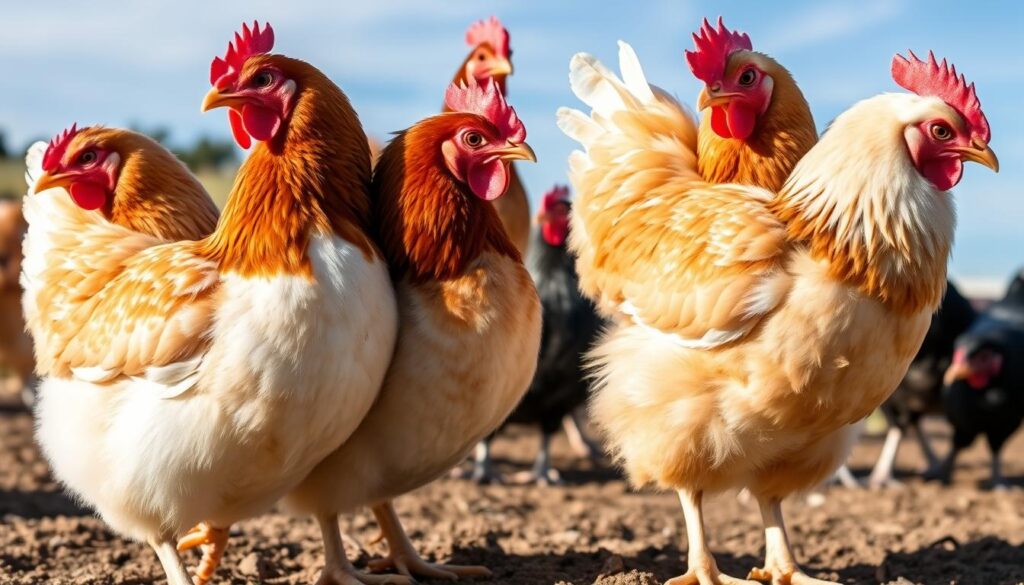
Tracking and analyzing growth data for broiler chickens is key to improving their performance and profit. Broiler chickens grow fast, gaining about 66g (.146 lbs.) every day in the first 42 days. Early growth is important for their health and growth later on.
By regularly weighing broilers, farmers can manage their flock better. This helps them reach the birds’ full growth potential.
Monitoring and analyzing broiler chicken growth data is vital. It helps farmers manage their poultry farms better. They can track how to track and analyze growth data for broiler chickens, poultry farm management, broiler weight tracking, data analytics for broilers, monitoring broiler growth rates, optimizing broiler feed efficiency, and broiler flock performance metrics.
This approach leads to better decisions, more efficient feed use, and higher profits. It’s a smart way to run a broiler operation.
Key Takeaways
- Tracking broiler growth data is crucial for optimizing flock performance and profitability
- Broiler chickens have high genetic potential for rapid weight gain in the first 42 days
- Good early chick development positively impacts long-term growth and metabolism
- Actively weighing broilers provides vital data to better manage and optimize the flock
- Data-driven analysis can improve decision-making, feed efficiency, and overall profitability
Importance of Tracking Broiler Chicken Growth
Broiler weight is key when raising broiler chickens. The goal is to get the most meat with the least feed. In the first 7 days, 80% of a bird’s energy goes to growth. This shows how important the early days are.
Broilers grow fast, increasing their weight by 450% in just 7 days. By day 42, they can weigh up to 2,800g (6 lbs.). The early growth of chicks greatly affects their performance later on.
Early Growth and its Impact on Broiler Performance
Good early growth improves a chick’s nutritional maturity, gastrointestinal tract development, muscle growth, and metabolic effects. This period sets the stage for the broiler’s market weight and efficiency.
Tracking broiler weight tracking and early broiler growth is crucial for broiler performance and broiler growth impact. Monitoring these metrics helps producers spot and fix issues. This ensures broilers reach their full potential and boosts profits.
Growth Curve Models for Broiler Chickens
Researchers have used different non-linear growth curve models to study broiler chicken growth. Models like the Gompertz, Logistic, and Richards functions help understand broiler growth phases. They also help find out what affects growth rates. By using these models, producers can improve feeding strategies and compare different broiler strains.
The Gompertz model is especially popular for analyzing broiler growth. It accurately shows the growth pattern of broilers, from fast growth to slowing down towards a maximum weight. Studies have found that the Gompertz model is more accurate than other models like the Von Bertalanffy and Logistic models.
| Model | MAPE (%) | Accuracy Rate (ρ%) |
|---|---|---|
| Gompertz | 2.81% | 97.19% |
| Von Bertalanffy | 2.92% | 97.08% |
| Logistic | 3.02% | 96.98% |
Using these non-linear growth curve models helps poultry producers a lot. They can understand what affects broiler growth, like genetics and nutrition. This knowledge helps producers make better decisions to improve broiler performance and production outcomes.
“The Gompertz model has proven to be a reliable tool for accurately describing the growth patterns of broiler chickens, enabling producers to make data-driven decisions to enhance their operations.”
Factors Affecting Broiler Growth
Broiler chickens grow in many ways, including how much they eat and their living conditions. Knowing these factors helps us manage their growth better. This is key to getting the most out of their growth and productivity.
Feed Restriction and its Impact
Good food is vital for broiler chickens to grow well. They need high-protein food to develop healthily and reach their full size. But, not eating enough early on can affect their performance in different ways.
Research shows that some unevenness in their food is okay. But, it’s important to mix their feed well to help them grow best.
Environmental Conditions and Broiler Growth
The environment, like temperature and air quality, greatly affects broiler growth. Keeping the temperature right, between 70-75 degrees Fahrenheit, is crucial. This helps them grow and stay healthy.
Studies reveal that too much heat or cold can hurt their growth. For example, heat stress makes them 171 grams lighter. Cold stress also has negative effects, making them lighter and less efficient with food.
| Environmental Factor | Impact on Broiler Growth |
|---|---|
| Heat Stress | 171 g lower weight, 0.06 g/g higher FCR |
| Cold Stress | 111 g lighter, 0.36 g/g higher FCR |
| Optimal Temperature (70-75°F / 21-24°C) | Supports healthy growth and development |
Other things like lighting, litter, and altitude also matter. A good plan that considers all these factors is key to better broiler production.
How to Track and Analyze Growth Data for Broiler Chickens
Monitoring and weighing broiler chickens is key to their growth. Advanced tools help collect data for better flock management.
These tools track individual bird weights and provide metrics like daily growth rates. They also show flock uniformity and compare performance against breed standards.
Some systems also track mortality rates and alert to trends. This lets producers quickly spot and fix issues affecting growth and performance.
| Key Broiler Growth Data Metrics | Benefits |
|---|---|
| Average Daily Weight Gain | Measure growth rate to ensure birds are on target |
| Daily Actual Weight | Track individual bird progress against breed standards |
| Coefficient of Variation | Assess flock uniformity for more efficient management |
| Mortality Rates | Identify and address health issues impacting performance |
Using these tools and analyzing data helps producers make better decisions. This optimizes growth, health, and efficiency in broiler flocks.

Data Analytics for Broiler Growth
Advanced data analytics techniques like machine learning and data mining can enhance broiler growth analysis. These methods uncover hidden patterns and trends in large datasets. For instance, decision trees can classify broiler flocks based on growth performance. Regression models can also predict future growth rates using past data.
Using these tools offers valuable insights for better management decisions. It helps optimize broiler production.
Machine Learning and Data Mining Techniques
Researchers have explored machine learning and data mining to improve broiler weight estimation. A new framework has shown great results, outperforming others. It boasts an MAE of 0.093 kg and an R2 of 0.707 on a test set of 240 images.
Traditional methods for weighing broilers include various measurements. Since 2003, computer vision has been used to estimate broiler weight through cameras. Studies have shown its feasibility.
Mortensen et al. used Microsoft Kinect depth cameras for 3D image data. Computer vision methods have three stages: image segmentation, feature extraction, and weight estimation.
| Technique | Description | Key Findings |
|---|---|---|
| Marker-based Watershed Segmentation | Used by Mortensen et al. to isolate broiler images for weight estimation | Effective in segmenting broiler images from complex backgrounds |
| Threshold-based Algorithms | Employed by Wang et al. for image segmentation | Simplistic but can be sensitive to lighting conditions and image quality |
| Regression Equations | Used by Amraei et al. for weight estimation | Showed positive results in predicting broiler weight |
| Artificial Neural Networks (ANN) | Utilized by Wang et al. for weight estimation | Demonstrated improved accuracy compared to regression models |
As broilers grow older, weight estimation errors increase. This is due to uneven growth and crowded conditions. A new framework uses multi-feature fusion and a gradient boosting decision tree to improve accuracy for older broilers.
Precision Poultry Farming and Smart Broiler House Technologies
The broiler industry is seeing a big leap in smart tech and precision farming. These changes help collect more data and make better decisions. Automated weighing systems let farmers track their birds’ growth in real-time. This helps spot and fix problems fast.
Also, new sensors, IoT devices, and data tools help monitor and improve broiler housing and feed. These advancements are key to better growth and productivity.
Precision feed livestock management, powered by technologies like deep learning and computer vision, can significantly reduce feed wastage in broiler farming. New tech in farming can save broiler farmers a lot of money. Computer vision uses images to guess a bird’s weight right away. Deep learning helps find the best food for chickens, making them healthier and eat less.
Smart sensors in poultry houses give real-time data on things like temperature and air quality. IoT tech makes farming more efficient, needing less labor. Big data tools help farmers make better choices by analyzing this data.
| Technology | Impact |
|---|---|
| Precision Feeding Systems | Ensure efficient feed utilization and minimize environmental impact |
| Environmental Monitoring Systems | Regulate temperature, humidity, and gas concentrations, enhancing bird health and production efficiency |
| Computer Vision for Health Monitoring | Enable early detection of illness, stress, or injury in broiler chickens, reducing the need for antibiotics and improving animal welfare |
These precision poultry farming and smart broiler house technologies are changing digital agriculture for broilers. They help farmers work better, produce more, and do it in a way that’s good for the planet.
Comparing Broiler Growth to Breed Standards
Broiler producers need to track their birds’ growth against breed standards. This helps them spot any issues early. They can then fix these problems to help the birds grow better.
Studies by Cobb-Vantress in 2012 showed how important feed efficiency is. They also found that how well the birds digest their food matters a lot. This knowledge helps producers understand how to feed their broilers better.
A study by Havenstein et al. in 1994 looked at how broilers have improved over the years. They found big gains in growth and feed use. Another study by Kras et al. in 2013 showed how diet and genetics affect broiler digestion. This is key for tracking their growth.
| Broiler Breed | Slaughter Weight (kg) | Days to Slaughter | Mortality Rate |
|---|---|---|---|
| Ross 308 | 2.52 | 38 | Higher |
| Hubbard Redbro | 2.32 | 43.5 | Lower |
The table shows how different broiler breeds grow and perform. The Ross 308 grows faster but has higher mortality. The Hubbard Redbro grows slower but has better health.
By watching how broilers grow and comparing them to breed standards, producers can do better. They can improve how their birds grow, care for them better, and make their operations more efficient and sustainable.

Impact of Egg Weight on Chick Growth
Egg weight is key for broiler chicks’ early growth. Heavier eggs lead to bigger, stronger chicks with faster growth. This is crucial for broiler producers to improve their breeding and incubation.
Relationship between Egg Weight and Hatchability
Egg weight also affects hatchability. Larger eggs usually have higher hatch rates. This means a better start for the broiler flock. Producers can make better choices about breeding and egg selection by understanding this.
Recent studies have shown egg weight’s impact on broiler performance. Hatching on-farm (HOF) chicks started heavier than hatchery-hatched (HH) chicks. They stayed heavier because they ate more, not because they were more efficient.
| Trait | HBW Group | LBW Group |
|---|---|---|
| Acetate concentration on day 14 | Higher | – |
| Isocaproate on day 7 | – | Higher |
| Isobutyrate on days 14 and 38 | – | Higher |
The data clearly shows egg weight’s impact on broiler growth. By understanding these patterns, producers can optimize their operations. This ensures the best start for their broiler chicks.
Automated Behavior Monitoring for Broiler Welfare
In the poultry industry, keeping broiler chickens safe and healthy is key. New tech now helps track their behavior and welfare. These digital tools for broiler welfare change how producers check on their birds.
Video-based activity monitoring is one such tech. It uses pixel change analysis to see how active the chickens are. This helps spot issues like inactivity or lesions early on.
These automated broiler behavior monitoring systems help assess welfare better. Producers can tackle problems quickly, keeping their flocks healthy and productive. This use of digital tech improves animal care and farm success.
“Automated behavior monitoring empowers producers to make more informed decisions and deliver better care for their broiler chickens.”
The poultry industry is growing, and these digital tools for broiler welfare are key. They help improve animal care and support sustainable farming.
Tracking and analyzing growth data for broiler chickens is key to improving their performance and profitability. By regularly weighing and monitoring broilers, producers can learn a lot. This helps them manage their birds better and reach their full potential.
Using advanced data analytics and precision farming technologies gives valuable insights. These tools support making better decisions and improving broiler production continuously.
Investing in these tools and strategies can greatly benefit broiler welfare and profitability. By using growth data tracking and optimizing performance, producers can stay competitive. This is especially important as demand for high-quality poultry grows in the United States.
As the broiler industry evolves, using data-driven approaches and new technologies is crucial. By focusing on tracking and analyzing broiler growth data, producers can make better decisions. This improves their efficiency and ensures their businesses can thrive in the long run.